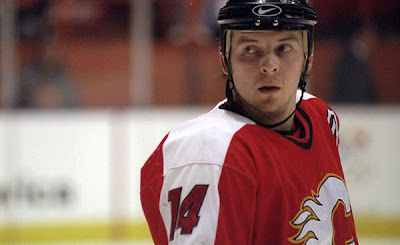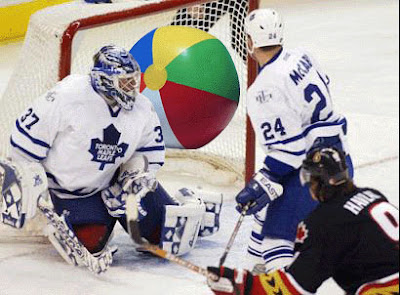
Kent is one of the earliest supporters of Cycle like the Sedins ... and certainly one of the most generous. Every time we've asked him to contribute something, he's come through.
So, naturally, we asked him to provide some Calgary Flames draft thoughts. Since we knew that Kent takes a deep (but still coherent to the Average Joe Stain Shirt in all of us) look at stats at Five Hole Fanatics, we thought we'd ask him a specific question before we got to the general stuff.
Make sure to follow Kent's work at Five Hole Fanatics as well as Matchsticks & Gasoline, the Calgary Flames blog at Sports Blog Nation.
1. We've asked a lot of bloggers about their given teams' plans, but we've really enjoyed reading your statistical analysis-related works. So we thought we'd ask you: if you were a GM, which factors (intangible as well as statistical) would weigh most heavily for you when deciding on a prospect?
1.) In terms of statistical factors, a ton of good work has been done on this topic recently. Before we get to the more advanced material, I'll discuss the basic numbers stuff I personally look for:
a.) Contextually based offense. Like in the big leagues, a prospect whose output is based on favorable circumstances (good linemates, lots of PP time) is a red flag to me. For example, I wrote this recently about Carter Ashton in a draft preview:
...while he was leading goal scorer on his club, he was actually 5th in terms of total points (50) and 6th in terms of PPG pace (0.71). Of the top 10 scorers on the Hurricanes, Carter scored the most PP goals (10) and had the worst plus/minus (-5). Remmerde also notes that Ashton slumped in the second half of the season after being taken off a line with leading assist man and point getter Colton Sceviour. The downturn was a marked one and visible by glancing at the game-by-game results: from January - March, a period of 31 games, Ashton scored just 9 goals and was a cumulative -18. Yikes. That slump continued into the post season where he scored just 1 goal and 3 points in 11 games (and was a team worst -8).
Link here.
Time will tell if my misgivings about Ashton prove correct. Point is, stats can suggest which players are driving results and which ones are riding coattails.
b.) Year-over-year Progression. A more "macro" approach to prospect evaluation is looking at how a given player improves every year. While a year or two isn't a big issue for grown men, it can be significant for teenagers. In the CHL, a 16 year old rookie would be playing against 18, 19 and 20 year old guys for example. A kid who doesn't take a few steps forward every year is another red flag: his numbers should improve just by virtue of aging and playing in a league with markedly younger and more physically immature guys. In addition, every prospect aside from the odd phenom has to improve by several orders of magnitude in order to eventually make the big league - and he only has a limited "development window" before he ceases being a prospect. A guy who isn't moving in the right direction each season is bad news, right Angelo Esposito?
Now on to the advanced stuff. Oilers super blogger Lowetide had a good post recently on "NHLE" or NHL Equivalency ratings based on the stellar work of behindthenet.ca owner and operator Gabrieal Desjardins. Desjardins has created a method of converting a prospects junior stats to an equivalent output at the NHL level based on their age and what amateur league they played in. The methodology is a bit complicated, but basically it takes a players PPG (point per game) rate and multiplies it by a ratio to get the converted "expected" NHL output of the prospect in question.
Another Oilers blogger, Jonathan Willis, has started to look at the percentage of team offense to grade prospects. Basically, that means taking a kids point production in his draft season and dividing it by his club's goals for total. It's a simple calculation, but an elegant idea: it "corrects" for team circumstances and gives us an idea of the degree to which the guy contributed to his club's offensive totals. His initial investigations into this method are encouraging, with the percentage ranking outperforming scouts in the '98 and '00 drafts.
As far as tools and intangibles, I prefer prospects who can skate well and have high utility (can contribute in more than one area of the ice). I'm also not as enamored with big guys as most scouts and fans seem to be meaning I would have no qualms taking a little guy who performs over a big guy that "projects well".
2. Tell us about some of the steals and busts in Flames' drafting history.
Steals:
1.) Joe Nieuwendyk, 27th overall, 1985.
The Flames picked a lanky center from Cornell University who managed 21 goals and 45 points in 29 games during his Freshman year. He went on to score 51 goals in his rookie season in 87/88 and won the Calder trophy as the NHL's best rookie. He was a major part of the 1989 cup winning team and probably stands as one of the best Flames players and draft picks ever. The cherry on top is the fact that Nieuwendyk was dealt for a relatively unknown 11th overall pick named Jarome Iginla in 1995.
2.) Theoren Fleury, 166th overall, 1987.
Calgary scouts took a chance in the 8th round on a tiny, explosive dynamo who was ripping up the WHL at the time, but who was passed over by other teams due to "size concerns". Fleury scored a mind-boggling 61 goals and 129 points for the Moose Jaw Warriors in his draft season and followed it up with a 68 goals, 160 point performance the next year. At the NHL level, it only took Fleury 3 seasons to breach the 50 goal, 100 point mark. Over the course of his career with Calgary, he'd score 30+ goals and 70+ points 6 times (it would have been 7 save for the lock-out in 94). He had held the Flames Franchise record for goals scored (830) which was recently broken only this past season by the aforementioned Iginla.
3.) Brett Hull, 117th overall, 1984.
Although he played just 57 games as a Calgary Flame, the hall-of-famer stands indisuptibly as the best pure scorer ever chosen by the organization. In addition, his trade to the St. Louis Blues brought Doug Gilmour to town, setting the stage for the Flames Stanley Cup win in '89.
Busts:
1.) Trevor Kidd, 11th overall, 1990.
Tabbed as the future franchise goalie, Kidd was the first goaltender chosen in the 1990 entry draft. And while he did go on to have something of a decent if unspectacular 387 game career in the NHL, the real reason he's on this list is the second goalie picked that year (at 20th overall) by the New Jersey Devils was Martin Brodeur. For more than a decade afterward, the Flames franchise floundered and sunk, due in no small part to on-going problems in net. In contrast, The Devils (backed by one of greatest puck stoppers of all time) became an NHL super power.
2.) Daniel Tkaczuk, 6th overall, 1997.
Another reason the Flames stunk in the mid-90's was their woeful drafting record. Tkaczuk was a scoring winger out of the OHL that never managed to put things together at the next level, partially due to concussion issues. By taking him 6th overall, the Flames left Sergei Samsonov (8th), Marian Hossa (12th), Scott Hannan (23rd) and Brendan Morrow on the table.
3.) Rico Fata, 6th overall, 1998.
Another high value pick, another big whiff. A swift skating winger out of the OHL, Fata had a single good year as a Junior - his draft year (98) where he put up 43 goals and 76 points. The fact that he was an 11 and 19 goal scorer the previous two seasons (and was only the 4th highest scorer on the club during the year in question) should have been a tip-off to the hapless Flames scouts at the time, but alas. Fata bounced around the NHL for several years, cobbling together a 230 game career somehow, but never really made a dent to any significant degree. By taking Fata 6th, the Flames missed out on Manny Malholtra (7th), Nik Antropov (10th), Alex Tanguay (12th), Martin Skoula (17th), Robyn Regehr (19th), Simon Gagne (22nd) and Scott Gomez (30th). Luckily the org was able to save this draft year by moving Theoren Fleury for a yet un-tested Robyn Regehr in 1999. As for Fata, his name remains a punchline in Flames fan circles to this day.










No comments:
Post a Comment